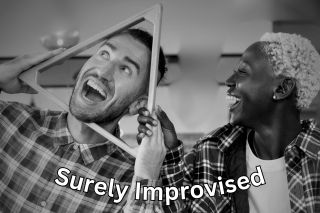Emotion Regulation
Art as Emotion Regulation
How does art defy extensive research findings on emotion regulation?
Posted May 18, 2024 Reviewed by Ray Parker
Key points
- Much emotion regulation research has focused on two strategies: suppression or reappraisal.
- Suppressing emotions is related to negative outcomes (e.g., depression, anxiety), and reappraisal positive.
- People use art to regulate emotions in three ways: avoiding, approaching, and self-development.
- Art for avoiding emotions isn't related to suppression, and art for self-development is healthy regulation.

Art helps us deal with our emotions. Expressing yourself, exploring your inner world, and creating something new changes our emotional experiences. Research has explored the ways that art allows us to regulate our emotions. But before I explain what was found about art and emotion regulation, I need to discuss the big findings from the last generation of emotion regulation research.
There is rich scientific literature examining two different ways of regulating emotions: expressive suppression and cognitive reappraisal. These are not the only ways to regulate emotions. There are many different strategies for influencing our feelings. These are just two common ways of dealing with emotions.
Expressive Suppression means not showing what you’re feeling. This is what people might describe as “stuffing it down” or “swallowing it.” It effectively ignores emotional responses so they don’t interfere with what you want to do.
Cognitive Reappraisal means reinterpreting your situation to try to change how you feel. This might mean “looking for silver linings” or “finding the opportunity” in a negative situation. It shifts your perspective in the hopes of shifting your feelings.
The well-researched and validated emotion regulation questionnaire asks about these two strategies. Someone who uses expressive suppression would agree strongly with statements like these:
- I keep my emotions to myself.
- I control my emotions by not expressing them.
Someone who uses cognitive reappraisal would agree strongly with statements like these:
- When I’m faced with a stressful situation, I make myself think about it in a way that helps me stay calm.
- I control my emotions by changing the way I think about the situation I’m in.
The big takeaway from the last generation of emotion regulation research is that cognitive reappraisal tends to be related to better outcomes than expressive suppression. By that, I mean that people who use suppression more tend to report more depressed mood, lower self-esteem, lower satisfaction with life, and feeling more distant and less accepted by others. In contrast, people who use reappraisals more tend to be less depressed, anxious, and stressed.
Further, these two emotion regulation styles have different effects on our bodies. People who use suppression tend to experience more activation of their sympathetic nervous system during stressful situations. This is the “fight-or-flight” system, and activation can often leave people feeling uncomfortable and keyed up. In contrast, reappraisal does not lead to this sympathetic activation. So not only do these emotion regulation strategies change how we feel (e.g., depressed, anxious), but they also affect our physiology, potentially contributing to health risks or burnout.
This is the context in which a team of researchers from London led by Daisy Fancourt developed the emotion regulation strategies for artistic creative activities scale (ERS-ACA). This team wanted to understand the ways in which people use art to regulate their emotions. They did this by reviewing previous research on how art can regulate emotions and developing a set of 170 questions. Each question asked about an aspect of emotion regulation in art. Through discussion and evaluation, they reduced this to 45. Then, based on two large-scale studies (one of which recruited almost 48,000 people to take the survey), they identified three core themes.
One way people use art to regulate their emotions is through avoiding feelings. People who use art this way would agree strongly with statements like this:
- When I’m making art, I can block out any unwanted thoughts or feelings.
- Art helps me forget about my worries.
Another way people use art for emotion regulation is through approaching feelings. People who use art this way would agree strongly with statements like this:
- Art makes me reflect on my emotions.
- When I make art, I can contemplate what is going on in my life with a clear mind.
The third way they found that people use art for emotion regulation is through self-development. People who use art this way would agree strongly with statements like this:
- When I make art, I feel more confident in myself.
- When I make art, it reaffirms my identity.
All people who use art to help them deal with their emotions use a mix or combination of these strategies. For example, they might use it both to avoid feelings and for self-development.
What’s interesting is how these strategies relate to the well-studied expressive suppression and cognitive reappraisal strategies. People who use art to avoid emotions aren’t suppressing their emotions. They’re also not likely to experience the negative effects of suppression. They’re finding a healthy way to step away from their emotions.
People who use art to approach their feelings are more likely to use cognitive reappraisal. The art itself seems to be one way to help reinterpret their experiences. They are likely to see the benefits of the cognitive reappraisal strategy—reduced depression, anxiety, and stress.

Using art for self-development was related to less expressive suppression and more cognitive reappraisal. Using art to help understand who you are more deeply may both eliminate the need to suppress your emotions and help you reinterpret your experiences and integrate them into your understanding of who you really are. This may be the most beneficial way that art can affect our emotional lives. It both helps us express ourselves and helps us turn difficult experiences into a part of our own stories.
In my current role working at a mental health facility, I regularly lead improv workshops with individuals who have experienced trauma. I find that giving people a safe place to be imaginative, playful, and expressive helps to break through the negative emotions people can find themselves stuck in. It also opens up a side of people that is curious and expressive, where they can explore associations within themselves. These classes are often a source of joy. The research on using art to deal with our emotions suggests that it can go even deeper and help people more fully process their emotions and understand themselves.
References
Fancourt, D., Garnett, C., Spiro, N., West, R., & Müllensiefen, D. (2019). How do artistic creative activities regulate our emotions? Validation of the Emotion Regulation Strategies for Artistic Creative Activities Scale (ERS-ACA). PloS one, 14(2), e0211362.
Cameron, L. D., & Overall, N. C. (2018). Suppression and expression as distinct emotion-regulation processes in daily interactions: Longitudinal and meta-analyses. Emotion, 18(4), 465.
Sörman, K., Garke, M. Å., Isacsson, N. H., Jangard, S., Bjureberg, J., Hellner, C., ... & Jayaram‐Lindström, N. (2022). Measures of emotion regulation: Convergence and psychometric properties of the difficulties in emotion regulation scale and emotion regulation questionnaire. Journal of Clinical Psychology, 78(2), 201-217.




